
Interview with Oliver Schmidt.
1. Prussian Rifles.
There was a Prussian production of rifles, and over the years slowly the Jägers and Schützen were equipped with them. Freiwillige Jägers brought their own rifles, of different calibers, so everybody had to make his own balls and cartridges.
Basically, I would say there was not big difference between the offcial pattern and the privately made ones. The advantage of having many (or, best, only) rifles of the same pattern within a unit are that it s easier to have spare parts for repair at hand, and the same caliber eases ammunitiopn supply a lot.
I haven't got data at hand about fire rate and range, there will have been no significant difference between Prussian and other rifles.
2. Differences in Training Between Jägers and Fusiliers.
Jägers were sharpshooters, aiming was very important.
Fusiliers would nomally be used as regular line infantry, even though all of them were able to skirmish (unlike the musketeers and grenadiers, in which only the 3rd rank was trained for skirmishing).
Jägers of course were trained in the regular movements of column and line, too, but were used in difficult terrain.
3. On Grenadiers' Uniforms.
In October 1814, the Grenadiers carried their particular sword tassels, and that the first two companies of each battalion had white and the other two red shoulder straps (yellow and mid blue respectively in the II. Ostpreußisches Grenadier-Bataillon).
The buttons on the shoulder straps of Grenadiers carried the number of the company within their parent regiment in Roman letters.
When the two grenadier regiments were formed, the initials of their respective chefs were sewn in woolen cord on their shoulder straps, and the sword tassels and buttons on the shoulder straps became like those of the other regiments.
4. Morale of the Freiwillige Jägers (Volunteer Jägers)
For the detachments of Freiwillige Jägers, the same applies as what I wrote about the morale of the other components of the army. Undoubtedly, many volunteers had a very high morale, but there were also men (espcially in 1815) who volunteered to avoid being drafted anyway and who just wanted to take part in the prerogativs given to the Freiwillige Jägers - or avoid being together with ordinary men whom some of them considered riff-raff ...
Discipline often was not as strict as in the line, training was not very thorough, so I wouldn't rank these volunteers above average.
Many of these volunteers came from towns, had never fired a shot before they bought their rifle, and they were not as fit and healthy as the men from the countryside who filled the ranks of the line.
The mixture of basically high motivation and generally bad bodily and training condition was different for every detachment, much depended on the commander of the detachment. And, of course, also the "moral" of the Freiwillige Jägers detachments would raise with the experience gained on campaign.
5. Organization of Regiment, Battalion and Company.
The existence of a third rank in infantry was vital, as its men were taken for skirmishing. So you would always form up in three ranks, in order to form the skirmishers platoons (Schützen-Züge). When the skirmishers had been taken out, the rest of the battalion of course consisted only of the two remaining ranks. So - for example - in a battalion of 400 men, you would form up in three ranks, take out the 4 skirmisher platoons formed from the third rank, 260 men would rest in the line in two ranks (1st and 2nd rank), making a front of 130 men.
I haven't come accross any definite source by now that after battles with unequal losses in the companies, men were transfered from one company to another in order to equalize the strength, but somehow this must have been done.
If battalions became too weak, they would be combined with other weak battalions. This happened for example after 15th June in the 2rd brigade, when the maimed Fusilier-Bataillon of the 28. Infanterie-Regiment (over 600 men lost) and the 3. Bataillon of the 2. Westphälisches Landwehr-Infanterie-Regiment were combined in one battalion.
In the company of Muketiers or Fusiliers formed up in the regulation strength prescribed on 12th January 1813 the distance between the ranks is 2 Fuß (63 cm) measured from back to breast. The Unteroffiziere's rank is 2 Schritt (146 cm) from the third rank of the company. The Seconde-Lieutenant's rank is 2 Schritt (146 cm) behind the Unteroffiziere's rank.
The men are equally distributed into two Züge (platoons), who were numbered according to their position in the battalion, counting from the right of the battalion deployed in line.
The 1st company consists of the 1st and 2nd Zug, the 2nd company of the 3rd and 4th Zug, etc.
The senior company or Zug (with the lower number) was always formed up on the right. The files were also counted starting from the right.
Each Zug was divided into Sektionen, which should have 6 or 5 files. If there were not enough men to fill the last file on the left of the Zug, the place in its second and third rank was to remain free.
The senior and the junior Seconde-Lieutenant are behind the comapny's first Zug, the second Seconde-Lieutenant is behind the company's second Zug.
The Feldwebel's position is behind the 2nd file of the company's first Zug.
When Kapitain or Premier-Lieutenant leave their position, they are replaced by the Unteroffizier from the third rank behind them. When the Kapitain commands the whole company, his place is taken by the senior Seconde-Lieutenant.
When the battalion was formed up in line, at least one Unteroffizier of each company was detached to the colour section. All the drummers and buglers were formed up in one rank behind the right wing of the 5th Zug, at a distance of 2 Schritt (146 cm) behind the rank of officers. If there were musicians, they would be formed up behind the left wing of the 4th Zug.
Prussian infantry company according to the regulation of 12 January 1813
ppppppppppppppppppppppppppppppP . pppppppppppppppppppppppppppppK sss
pppppppppppppppppppppppppppppp . . ppppppppppppppppppppppppppppp
.pppppppppppppppppppppppppppppU . pppppppppppppppppppppppppppppU
. . U . . . . U . . . . U . . . . U . . . . U . . . U . . . . . . U . . . . U . . . . U . . . . U . . . . U . . . F
. . . . . . . . . . . . . . S . . . . . . . . . . . . . . . . . . . . . . . . . . . . . . . . S . . . . . . . . . . S
K Kapitan (1)
P Premier-Leutenant (1)
S Seconde-Leutenant (3)
F Feldwebel (1)
U Unteroffizier (14)
p private (182)
s Spielmann (drummer) (3)
Above is a Prussian infantry company according to the regulation of 12 January 1813 and its formation according to the 1812 regulation for infantry. Unfortunately, it was not printed in my Osprey title.
From the same date, the officers of the battalion were to consist of 1 staff officer as battalion commander (A "staff officer" - Stabsoffizier- can be any rank above Kapitan/Hauptmann and below general. For example: Major, Oberst-Lieutenant or Oberst), 1 adjudant (usually a Seconde Lieutenant), 1 "Rechnungsführer" (account manager, usually also a Seconde Lieutenant) and 17 other officers distributed to the companies.
These officers were lower officers: probably 1 captain, 1 Premier-Lieutenant and 1 Secode-Lieutenant per company - there will have been variations.
From 2 December 1808, in peacetime, a regiment had 1 staff officer as commander (who will have been assigned a lieutenant from the regiment as adjudant).
Per battalion, there was 1 Büchsenmacher (gun maker) and per regiment 1 Büchsenschäfter (gun stock maker). For each battalion, there was a Bataillons-Tambour (named Bataillons-Hornist - battalion bugler - from 1811), and in addition 1 Regiemtns-Tambour. The regiments were allowed 10 regular (paid) "Hautboist"s (musicians), but most officer corps put together some money to increase this number in order to afford a bigger regimental band.
In each company, a few men carried an axe, a pickaxe or a spade. The soldiers disliked the extra weight. These items could hinder the aiming of the second rank.
In May 1815, on its own initiative, the I/23. Infanterie-Regiment had formed an extra section of 12 pioneers, who had been picked from the companies. On their left shoulder they carried axes instead of muskets and wore a shovel and a pickaxe on a sling over the back. They
formed up in one rank with the NCOs, behind the Color party. At Ligny they smashed
doors and windows of houses which had been occupied by the French,
making it much easier to dislodge the enemy. (No beard was required for the sapper.)
The battalion of jägers (or Schützen) had the same organisation, but according to the regulation of 12 January 1812 they had lesser numbers of rank and file (but the same number of officers as the regular infantry battalions): 40 NCOs, 9 buglers, 452 Jäger or Schützen
According to regulations issued on 24th February 1813 the detachments of Freiwillige Jägers
were formed in 2 ranks if below and in thre ranks if above a strength of 100 men.
On parade, the detachment stood on the right flank of the battalion. Marching past a superior, they were at the head of the battalion, in front of the musicians, the battalion commander and his adjudant at their (the volunteers') head.
For exercise, the detachemnt is 50 paces behind the middle of the battalion in line. In attack column (compare my Osprey Warrior), the first platoon of the detachment between the 2nd and 3rd platoon of the battalion, the second platoon of the detachment between the 6th and 7th platoon of the battalion (Means, the attack column is two platoons wide and 5 platoons deep).
They should be used for skirmishing, also for detachents and field duties, but shouldn't be fatigued too much. Their main purpose was to train the volunteers to become officers later - at least those who were apt for it.
When the two regiments of grenadiers were formed, they were organised along the pattern of the other infantry regiments: therefore their 3rd battalion was a battalion of Fusiliere (in which everybody, not only the men of the third rank, was to be trained as skirmisher). So each of the two Grenadier-Regimenter consisted of: 1. Bataillon, 2. Bataillon and Fusilier-Bataillon. However, the men of all the battalions were called Grenadiere. So you will find the denomination "Grenadier of the Fusilier-Bataillon of the Kaiser-Alexander-Genadier-Regiment".
In the Landwehr in the course of the campaigns in some regiments one battalion did specialise as Füsiliere, there is an order by Blücher of June 1815 that all the Landwehr regiments which did not yet have a Fusilier-Bataillon should appoint one.
Thank You Oliver
|


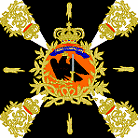

 "The infantry of Prussia in 1806 was 'a museum piece'
reflecting the great days of Frederick the Great
imposing in appearance but decidedly disappointing in performance.
and outdated in training. This was evident as early as Valmy in 1792, but few improvements had been wrought 14 years later.
The cult of the past was unshakeable, the tactics rigid, the supply train enormous, and a day's march of over 10 miles was considered excessive.
Its leadership was also antiquated, except for Prince Louis Ferdinand.
The disasters of Jena and Auerstadt and the succeeding weeks, and the humiliations of
Tilsit at length brought reform under the inspiration of Scharnhorst."
(Chandler - "Dictionary of the Napoleonic wars" p 210)
"The infantry of Prussia in 1806 was 'a museum piece'
reflecting the great days of Frederick the Great
imposing in appearance but decidedly disappointing in performance.
and outdated in training. This was evident as early as Valmy in 1792, but few improvements had been wrought 14 years later.
The cult of the past was unshakeable, the tactics rigid, the supply train enormous, and a day's march of over 10 miles was considered excessive.
Its leadership was also antiquated, except for Prince Louis Ferdinand.
The disasters of Jena and Auerstadt and the succeeding weeks, and the humiliations of
Tilsit at length brought reform under the inspiration of Scharnhorst."
(Chandler - "Dictionary of the Napoleonic wars" p 210)
 The Prussian infantry that joined the Allies against France in 1813 was of mixed quality.
The regular infantry wase well trained, well clothed and well armed. They were brave soldiers.
The reserve infantry was formed from various troops, and might have each battalion in different uniform,
and several types of muskets. Most of them however performed in combat quite well.
There were also volunteer units, they armed and uniformed themselves.
The volunteers were enthusiastic but lacked training and physical toughness.
The Landwehr infantry was a national levy of all men betweem 17 and 40
capable of bearing weapons. They lacked weapons and uniforms.
Many wore either captured French greatcoats or civilian clothes.
The older men capable of bearing arms went into Landsturm. They were poorly armed and saw little duty.
The Prussian infantry that joined the Allies against France in 1813 was of mixed quality.
The regular infantry wase well trained, well clothed and well armed. They were brave soldiers.
The reserve infantry was formed from various troops, and might have each battalion in different uniform,
and several types of muskets. Most of them however performed in combat quite well.
There were also volunteer units, they armed and uniformed themselves.
The volunteers were enthusiastic but lacked training and physical toughness.
The Landwehr infantry was a national levy of all men betweem 17 and 40
capable of bearing weapons. They lacked weapons and uniforms.
Many wore either captured French greatcoats or civilian clothes.
The older men capable of bearing arms went into Landsturm. They were poorly armed and saw little duty.
 Picture: Prussian flags of pre 1806 pattern. Leibfahne (left) and Regimentsfahne (right).
Source:
Picture: Prussian flags of pre 1806 pattern. Leibfahne (left) and Regimentsfahne (right).
Source:  Flag staffs were white except for 12 battalions, which had black:
Flag staffs were white except for 12 battalions, which had black:  Picture: forming battalion column of Zuge from line
Picture: forming battalion column of Zuge from line  Picture: forming battalion column from line. Exerzir Reglement
fur die Infanterie der Koniglich Preussischen Armee, 1812.
Picture: forming battalion column from line. Exerzir Reglement
fur die Infanterie der Koniglich Preussischen Armee, 1812.
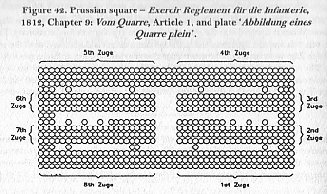 The Prussian infantry used closed columns instead of squares against cavalry.
When enemy's cavalry approached the outer files filled the gaps between the troops.
Such compact formaion was formed quickly, the troopers in 1st rank outstretched their
bayonets while those in 2nd rank fired. The men in 3rd rank loaded the muskets and passed to
the 2nd rank.
The Prussian infantry used closed columns instead of squares against cavalry.
When enemy's cavalry approached the outer files filled the gaps between the troops.
Such compact formaion was formed quickly, the troopers in 1st rank outstretched their
bayonets while those in 2nd rank fired. The men in 3rd rank loaded the muskets and passed to
the 2nd rank.
 General von Clausewitz was not happy with the method the Prussian infantry defended villages.
He wrote: "We use up our troops too fast in stationary combat. Our officers call for
support too soon, and it's given them too readily. The consequence is that we suffer
more dead and wounded without gaining any ground, and we transform our fresh soldiers
into burnt-out husks."
General von Clausewitz was not happy with the method the Prussian infantry defended villages.
He wrote: "We use up our troops too fast in stationary combat. Our officers call for
support too soon, and it's given them too readily. The consequence is that we suffer
more dead and wounded without gaining any ground, and we transform our fresh soldiers
into burnt-out husks."
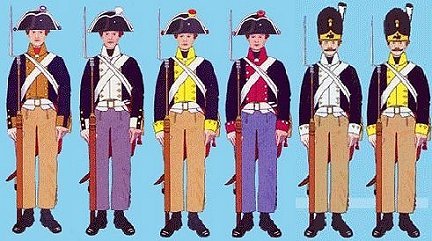 Picture: uniforms of Prussian infantry in the Jena Campaign in 1806.
Picture by Andre Jouineau.
Picture: uniforms of Prussian infantry in the Jena Campaign in 1806.
Picture by Andre Jouineau.  Picture: Prussian 11th Infantry Regiment, by Steven Palatka.
Picture: Prussian 11th Infantry Regiment, by Steven Palatka.
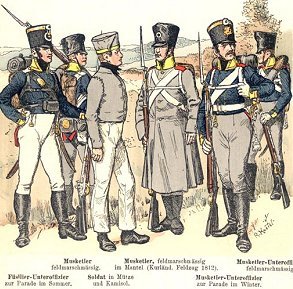 Picture: Silesian Infantry Regiment in 1812-1814, by Knotel.
From left to right: NCO of fusiliers, musketeer, private in depot, musketeer in campaign dress, NCO of
musketeers in winter parade dress, and NCO of musketeers in typical combat outfit.
Picture: Silesian Infantry Regiment in 1812-1814, by Knotel.
From left to right: NCO of fusiliers, musketeer, private in depot, musketeer in campaign dress, NCO of
musketeers in winter parade dress, and NCO of musketeers in typical combat outfit.
 "The uniforms of the Reserve Infantry Regiments may be divided into four types:
"The uniforms of the Reserve Infantry Regiments may be divided into four types:

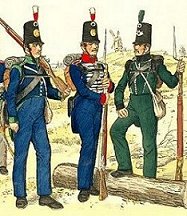 Left: Prussian reserve infantry. Picture by Steven Palatka.
Left: Prussian reserve infantry. Picture by Steven Palatka.
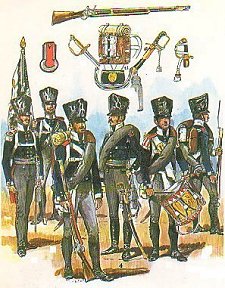 Right: Prussian line infantry in 1813. Picture by de Beaufort, France.
Right: Prussian line infantry in 1813. Picture by de Beaufort, France.
 Picture: Regiment of the Foot Guard in 1808 in Konigsberg, Eastern Prussia.
Picture: Regiment of the Foot Guard in 1808 in Konigsberg, Eastern Prussia.
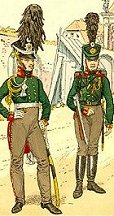 Picture: Guard Jagers in 1810 (in our opinion they were creme de la creme of
the Prussian light infantry). Picture by Knotel.
Picture: Guard Jagers in 1810 (in our opinion they were creme de la creme of
the Prussian light infantry). Picture by Knotel.
 The Guard Brigade have participated in some heavy fighting during the campaign of 1813
in Saxony.
The Foot Guard Regiment and Guard Jäger Battalion had very high losses at Großgörschen
(Lutzen).
They did fight in 1813 in
The Guard Brigade have participated in some heavy fighting during the campaign of 1813
in Saxony.
The Foot Guard Regiment and Guard Jäger Battalion had very high losses at Großgörschen
(Lutzen).
They did fight in 1813 in

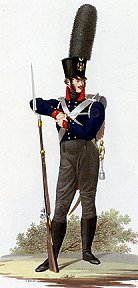 For war the grenadier companies formed battalions (4 companies each).
For war the grenadier companies formed battalions (4 companies each).
 Picture: musketiers of 1st and 2nd West Prussia Infantry Regiment
in War of Liberation in 1813. Picture by Knotel.
Picture: musketiers of 1st and 2nd West Prussia Infantry Regiment
in War of Liberation in 1813. Picture by Knotel.
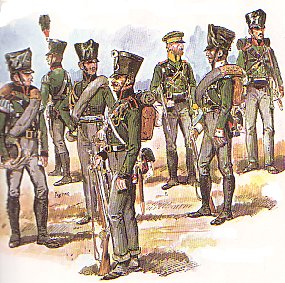 Picture: from left to right: two buglers of the Silesian jagers
(in campaign and parade uniform), officer and private of the Silesian jagers,
three volunteer-jagers (freiwillige-jagers).
Picture: from left to right: two buglers of the Silesian jagers
(in campaign and parade uniform), officer and private of the Silesian jagers,
three volunteer-jagers (freiwillige-jagers).
 The Schützen were armed with rifles with front and back sight. These were excellent
marksmen although - unfortunately - were partially armed with smoothbore muskets instead of
rifles. The Schützen were intended to fight in similar way as the Jägers.
The Schützen were armed with rifles with front and back sight. These were excellent
marksmen although - unfortunately - were partially armed with smoothbore muskets instead of
rifles. The Schützen were intended to fight in similar way as the Jägers.
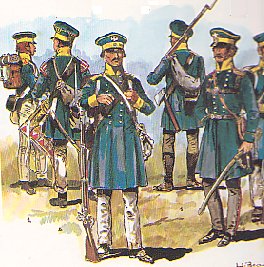 Picture: Silesian landwehr, by de Beaufort, France.
Picture: Silesian landwehr, by de Beaufort, France.
 Picture: Battle of Lutzen, picture by Oleg Parkhaiev of Russia.
On the left Prussian Landwehr.
Picture: Battle of Lutzen, picture by Oleg Parkhaiev of Russia.
On the left Prussian Landwehr.
 "The Prussian Landwehr regiments adopted and carried in the field many unofficial designs of flags prior to the
issuing of the order of 30th September 1813 which prohibited their further use.
"The Prussian Landwehr regiments adopted and carried in the field many unofficial designs of flags prior to the
issuing of the order of 30th September 1813 which prohibited their further use.

